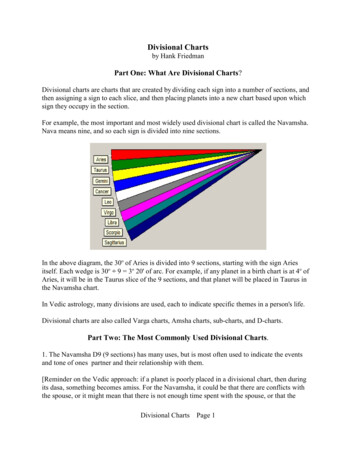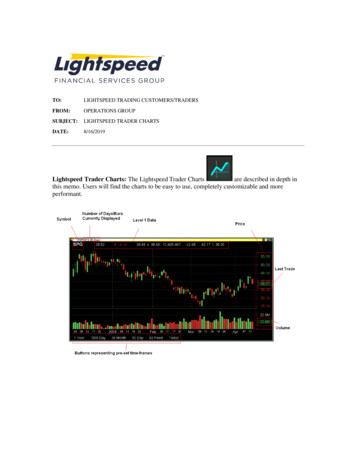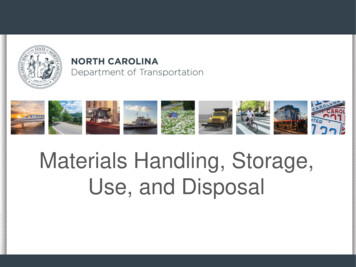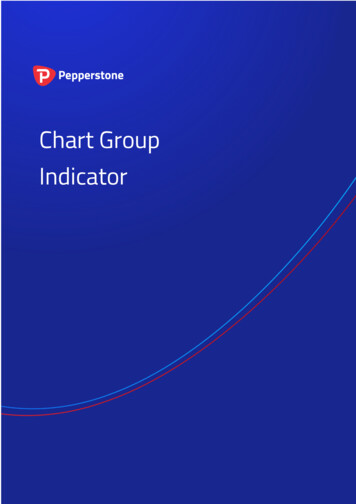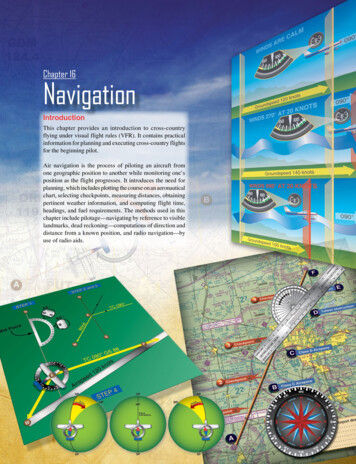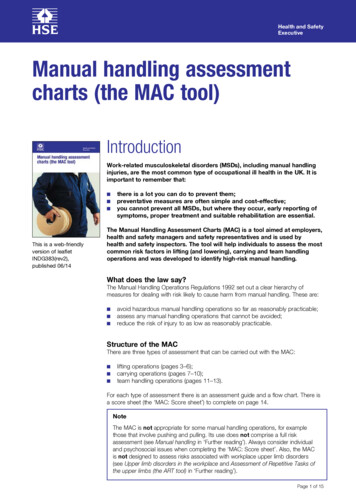
Transcription
Health and SafetyExecutiveManual handling assessmentcharts (the MAC tool)IntroductionWork-related musculoskeletal disorders (MSDs), including manual handlinginjuries, are the most common type of occupational ill health in the UK. It isimportant to remember that: This is a web-friendlyversion of leafletINDG383(rev2),published 06/14there is a lot you can do to prevent them;preventative measures are often simple and cost-effective;you cannot prevent all MSDs, but where they occur, early reporting ofsymptoms, proper treatment and suitable rehabilitation are essential.The Manual Handling Assessment Charts (MAC) is a tool aimed at employers,health and safety managers and safety representatives and is used byhealth and safety inspectors. The tool will help individuals to assess the mostcommon risk factors in lifting (and lowering), carrying and team handlingoperations and was developed to identify high-risk manual handling.What does the law say?The Manual Handling Operations Regulations 1992 set out a clear hierarchy ofmeasures for dealing with risk likely to cause harm from manual handling. These are: avoid hazardous manual handling operations so far as reasonably practicable;assess any manual handling operations that cannot be avoided;reduce the risk of injury to as low as reasonably practicable.Structure of the MACThere are three types of assessment that can be carried out with the MAC: lifting operations (pages 3–6);carrying operations (pages 7–10);team handling operations (pages 11–13).For each type of assessment there is an assessment guide and a flow chart. There isa score sheet (the ‘MAC: Score sheet’) to complete on page 14.NoteThe MAC is not appropriate for some manual handling operations, for examplethose that involve pushing and pulling. Its use does not comprise a full riskassessment (see Manual handling in ‘Further reading’). Always consider individualand psychosocial issues when completing the ‘MAC: Score sheet’. Also, the MACis not designed to assess risks associated with workplace upper limb disorders(see Upper limb disorders in the workplace and Assessment of Repetitive Tasks ofthe upper limbs (the ART tool) in ‘Further reading’).Page 1 of 15
Health and SafetyExecutiveHow to complete a MAC assessmentG GREEN - Low level of riskAlthough the risk is low, consider the exposure levels for vulnerable groups such aspregnant women or young workers, where appropriate.A AMBER - Medium level of riskExamine tasks closely.R RED - High level of riskPrompt action needed. This may expose a significant proportion of the workingpopulation to risk of injury.P PURPLE - Very high level of riskSuch operations may represent a serious risk of injury and should come under closescrutiny, particularly when the entire weight of the load is supported by one person. Spend some time observing the task (videoing may help) to ensure that whatyou are seeing is representative of normal working procedures. You shouldinvolve your employees and safety representatives during the assessmentprocess. Where several people do the same task, make sure you have someinsight into the demands of the job from all employees’ perspective.Select the appropriate type of assessment (ie lifting, carrying or team handling).If a task involves lifting and carrying, consider both.Follow the appropriate assessment guide and flow chart to determine the levelof risk for each risk factor. Information on risk reduction can be found on theHSE website at www.hse.gov.uk/msd and in the HSE publication Manualhandling at work (see ‘Further reading’).Enter the colour band and corresponding numerical score on the ‘MAC: Scoresheet’. The colour bands help determine which elements of the task requireattention.Enter the remaining task information and use the scores to help identify whichrisk factors need to be examined and the total level of exposure to risk.If the individual does a number of tasks, assess each one separately andprioritise action to address the highest scoring task.Further guidance on using the MAC tool can be accessed online atwww.hse.gov.uk/msd/mac.RememberThe purpose of the assessment is to identify and then reduce the overalllevel of risk of the task.Manual handling assessment charts (the MAC tool)Page 2 of 15
Health and SafetyExecutiveAssessment guide for liftingoperationsA Load weight/frequencyNote the weight of the load and the repetition rate of the lifting operation. Take noteof the risk banding from the graph below and enter the colour band and numericalscore onto the ‘MAC: Score sheet’. If the colour band is purple, the task should beexamined very closely, as such operations may represent a serious risk of injuryand should come under close scrutiny, particularly when the entire weight of theload is supported by one person. Note: High frequency handling operations oflight weights will fall within the green zone, but may be associated with upper limbproblems. Please refer to Upper limb disorders in the workplace and Assessment ofRepetitive Tasks of the upper limbs (the ART tool) (see ‘Further reading’) for adviceon further assessment.Load weight/frequency graph for lifting operationsP 10Weight of load (kg)50405040R 63030A 420102010G 000One lift perday30 minutes(2)5 minutes(12)2 minutes(30)1 minute(60)14 seconds(250)9 seconds(400)5 seconds(720)One lift every(lifts per hour)Manual handling assessment charts (the MAC tool)Page 3 of 15
Health and SafetyExecutiveB Hand distance from the lower backObserve the task and examine the horizontal distance between the operative’shands and their lower back. Always assess the ‘worst case scenario’. Use thefollowing to guide your assessment:Close: Upper armsaligned verticallyand uprighttorsoG/0Moderate: Upperarms angled awayfrom bodyModerate:Torso bentforwardA/3A/3Far: Upper armsangled away frombody and torsobent forward R/6C Vertical lift regionObserve the position of the operative’s hands at the start of the lift and as the lift progresses.Always assess the ‘worst case scenario’. Use the following illustrations as a guide:Above knee and/orbelow elbow heightG/0Below knee and/orabove elbow heightA/1Floor levelor belowAt head heightor aboveR/3D Torso twisting and sideways bendingObserve the operative’s torso as the load is lifted. If the torso twists in relation to thehips and thighs or the operative leans to one side as the load is lifted, the colourband is amber and the numerical score is 1. If the torso both twists and bends tothe side as the load is lifted the colour band is red and the numerical score is 2.Little or no torso twistingor sideways bendingG/0Torso twistingorsideways bendingTorso twistingandsideways bendingA/1Manual handling assessment charts (the MAC tool)R/2Page 4 of 15
Health and SafetyExecutiveE Postural constraintsIf the movements of the operative are unhindered, the colour band is green and thenumerical score is 0. If the operative adopts restricted postures during the lift because ofthe space available (eg a narrow gap between pallet load and hopper) or the workstationdesign (eg an excessively high monorail conveyor), the colour band is amber and thenumerical score is 1. If the posture is severely restricted, the colour band is red and thenumerical score is 3 (eg work in confined areas such as baggage holds).No postural constraintsRestricted postureA/1G/0Severely restrictedpostureR/3F Grip on the loadGood gripReasonable gripG/0Poor gripA/1R/2Containers with welldesigned handles orhandholds, fit for purposeContainers with poorhandles or handholdsContainers of poor design.Loose parts, irregularobjects, bulky or difficultto handleLoose parts enablingcomfortable gripFingers to be clampedat 90 degrees under thecontainerNon-rigid sacks orunpredictable loadsDry floor but in poorcondition, worn orunevenContaminated/wet orsteep sloping floor orunstable surface orunsuitable footwearG Floor surfaceDry and clean floor ingood conditionG/0A/1R/2H Other environmental factorsObserve the work environment and score if the lifting operation takes place:in extremes of temperature; with strong air movements; or in extreme lightingconditions (too dark or bright). If one of the risk factors is present score 1, if twoor more of the risk factors are present score 2.No factors presentOne factor presentG/0Two or more factorspresentA/1Manual handling assessment charts (the MAC tool)R/2Page 5 of 15
Health and SafetyExecutiveLiftingoperationALoad weight/frequency (seegraph on p3)BHand distancefrom lowerbackCVertical liftregionDTorso twistingand sidewaysbendingPlease insert the colour andNOTE THE COLOUR AND NUMERICALSCOREnumericalscores on theAND INSERT ON SCORE SHEET ‘MAC: Score sheet’See graph on p3GSee graph on p3ASee graph on p3R50 kg or moreP046HOtherenvironmentalfactorsGModerate: upperarms angled ortorso bent forwardAFar: upper armsangled and torsobent forwardRAbove knee and/orbelow elbowheightGBelow knee and/orabove elbowheightAFloor level or belowand/or abovehead heightRLittle or no torsotwisting orsideways bendingGTorso twistingorsideways bendingATorso twistingandsideways bendingR0Floorsurface61ReasonableE12Manual handling assessment charts (the MAC tool)0RNonePosturalconstraintsGContaminated,wet, sloping orunstablePoor32AFGrip onthe loadRDry but in poorcondition orunevenGood10AOne factorpresentDry and in goodconditionG300Two or morefactors present10Close: upper armsvertical/torsouprightGNo G0A1R3Page 6 of 15
Health and SafetyExecutiveAssessment guide for carryingoperationsA Load weight/frequencyNote the weight of the load and the frequency of the carrying operation. Take noteof the risk banding on the graph below and enter the colour band and numericalscore on the ‘MAC: Score sheet’. If the colour band is purple the task should beexamined very closely, as such operations may represent a serious risk of injuryand should come under close scrutiny, particularly when the entire weight of theload is carried by one person.Load weight/frequency graph for carrying operationsP 10Weight of load (kg)50405040R 63030A 420102010G 000One carry perday30 minutes(2)5 minutes(12)2 minutes(30)1 minute(60)12 seconds(300)One carry every(carries per hour)B Hand distance from the lower backObserve the task and examine the horizontal distance between the operative’shands and their lower back. Always assess the ‘worst case scenario’. Use thefollowing illustrations to guide your assessment:Close: Upper armsaligned verticallyand uprighttorsoG/0Moderate: Upperarms angled awayfrom bodyModerate:Torso bentforwardA/3Manual handling assessment charts (the MAC tool)A/3Far: Upper armsangled away frombody and torsobent forward R/6Page 7 of 15
Health and SafetyExecutiveC Asymmetrical torso/loadThe operative’s posture and the stability of the load are risk factors associated withmusculoskeletal injury. The following illustrations should guide your assessment.Load and handssymmetrical infront of thetorsoG/0Load and handsasymmetrical,upright bodypositionA/1One handedcarrying to theindividual’ssideR/2D Postural constraintsIf the operative’s movements are unhindered, the colour band is green and thenumerical score is 0. If the operative adopts restricted postures during the carry(eg a narrow doorway making the operative turn or move the load to get through)the colour band is amber and the numerical score is 1. If the posture is severelyrestricted, the colour band is red and the numerical score is 3 (eg carrying loads ina forward bent posture in areas with low ceilings such as cellars).No postural constraintsRestricted postureA/1G/0Severely restrictedpostureR/3E Grip on loadGood gripReasonable gripG/0Poor gripA/1R/2Containers with welldesigned handles orhandholds, fit for purposeContainers with poorhandles or handholdsContainers of poor design.Loose parts, irregularobjects, bulky or difficultto handleLoose parts enablingcomfortable gripFingers to be clampedat 90 degrees under thecontainerNon-rigid sacks orunpredictable loadsDry floor but in poorcondition, worn orunevenContaminated/wet orsteep sloping floor orunstable surface orunsuitable footwearF Floor surfaceDry and clean floor ingood conditionG/0A/1R/2G Other environmental factorsObserve the work environment and score if the carrying operation takes place:in extremes of temperature; with strong air movements; or in extreme lightingconditions (dark, bright or poor contrast). If one of the risk factors is presentscore 1, if two or more of the risk factors are present score 2.No factors presentOne factor presentG/0Two or more factorspresentA/1Manual handling assessment charts (the MAC tool)R/2Page 8 of 15
Health and SafetyExecutiveH Carry distanceObserve the task and estimate the total distance that the load is carried (not thedistance ‘as the crow flies’).2 m—4 m4 m—10 mG/010 m or moreA/1R/3I Obstacles en routeObserve the route. If the operator has to carry a load up a steep slope, up steps, throughclosed doors or around tripping hazards, the colour band is amber and the numericalscore is 2. If the task involves carrying the load up ladders, enter ‘R’ (red) for the colourband and 3 for the numerical score. If the task involves more than one of the risk factors(eg a steep slope and then up ladders) total the scores on the score sheet. Enter theladder height data and/or the angle in the task description box on the score sheet.No obstaclesandcarry route is flatSteep slope or up stepsor through closed doorsor trip hazardsG/0A/2Manual handling assessment charts (the MAC tool)LaddersR/3Page 9 of 15
Health and SafetyExecutivePlease insert the colour andnumerical scores on the‘MAC: Score sheet’CarryingoperationALoad weight/frequency (seegraph on p7)BHand distancefrom lowerbackCAsymmetricaltorso/loadSee graph on p7GSee graph on p7ASee graph on p7R50 kg or morePClose: upper armsvertical/torsouprightG0RAsymmetrical oroffset ablePoorObstaclesen route10Far: upper armsangled and torsobent forwardLoad symmetricalin front/two handsI6ANoneGrip onthe load4Moderate: upperarms angled ortorso bent forwardOne-handed toside or twisting/back bentPosturalconstraints0HCarrydistance36G0A1GSteep slope or upsteps or throughclosed doors ortrip hazardsAGOtherenvironmentalfactors2 m—4 mG4 m—10 mA10 m or moreR0A1RFloorsurface3013G0AOne factorpresent1Dry and in goodconditionF2RTwo or morefactors present20LaddersNo factorspresentRGNo obstaclesandcarry route is flatR2G0Dry but in poorcondition orunevenAContaminated,wet, sloping orunstableR123G0A1R2Manual handling assessment charts (the MAC tool)Page 10 of 15
Health and SafetyExecutiveAssessment guide for team handlingoperationsA Load weightNote the weight of the load and the number of operatives performing the task.Enter the colour band and numerical score on the ‘MAC: Score sheet’. If the colourband is purple the task should be examined very closely. Such operations mayrepresent a serious risk of injury and should come under close scrutiny, particularlywhen the entire weight of the load is supported by the team.2 person 35 kg3 person 40 kg2 person 35—50 kg3 person 40—75 kg4 person 40—100 kg2 person 50—85 kg3 person 75—125 kg4 person 100—170 kgR/6A/4G/02 person 85 kg3 person 125 kg4 person 170 kgP/10B Hand distance from the lower backObserve the task and examine the horizontal distance between each operative’shands and their lower back. Always assess the ‘worst case scenario’. Use thefollowing illustrations to guide your assessment:Close: Upper arms alignedvertically and uprighttorsoG/0Moderate: Torso bent forwardor upper arms angled away frombodyA/3Far: Upper arms angled awayfrom body and torsobent forwardR/6C Vertical lift regionObserve the position of the operatives’ hands at the start of the lift and as the liftprogresses. Always assess the ‘worst case scenario’. Use the following illustrationsas a guide:Above knee and/orbelow elbow heightG/0Below knee and/or above elbowheightManual handling assessment charts (the MAC tool)A/1At head height or above, or floorlevel or belowR/3Page 11 of 15
Health and SafetyExecutiveD Torso twisting and sideways bendingObserve the operatives’ torsos as they lift the load. If the torso twists in relation to thehips and thighs or if the operatives lean to one side as the load is lifted, the colourband is amber and the numerical score is 1. If the torso both twists and bends to theside as the load is lifted, the colour band is red and the numerical score is 2.Little or no torso twistingor sideways bendingTorso twistingorsideways bendingG/0Torso twistingandsideways bendingA/1R/2E Postural constraintsIf the movements of the operatives are unhindered, the colour band is green and thenumerical score is 0. If the operatives adopt restricted postures during the lift becauseof the space available (eg narrow space between team members) or the workstationdesign (eg an excessively high monorail conveyor), the colour band is amber and thenumerical score is 1. If the postures are severely restricted, the colour band is red andthe numerical score is 3 (eg work in confined areas such as baggage holds).No postural constraintsRestricted postureA/1G/0Severely restrictedpostureR/3F Grip on loadGood gripReasonable gripG/0Poor gripA/1R/2Containers with welldesigned handles orhandholds, fit for purposeContainers with poorhandles or handholdsContainers of poor design.Loose parts, irregularobjects, bulky or difficultto handleLoose parts enablingcomfortable gripFingers to be clampedat 90 degrees under thecontainerNon-rigid sacks orunpredictable loadsDry floor but in poorcondition, worn orunevenContaminated/wet orsteep sloping floor orunstable surface orunsuitable footwearG Floor surfaceDry and clean floor ingood conditionG/0A/1R/2H Other environmental factorsObserve the work environment and score if the lifting operation takes place:in extremes of temperature; with strong air movements; or in extreme lightingconditions (dark, bright or poor contrast). If one of the risk factors is present score 1,if two or more of the risk factors are present score 2.No factors presentOne factor presentG/0Two or more factorspresentA/1R/2I Communication, co-ordination and controlCommunication between the operatives is essential when lifting as part of a team.Examples of good communication would be that you may hear the operativescounting ‘one, two, three’ etc before the lift. Look to see if the team have control ofthe load, that it is lifted smoothly, and that all members lift together. Anunco-ordinated team lift may leave one member of the team bearing the entire weight.GoodG/0ReasonableA/1Manual handling assessment charts (the MAC tool)PoorR/3Page 12 of 15
Health and SafetyExecutivePlease insert the colour andnumerical scores on the‘MAC: Score sheet’TeamhandlingoperationALoad weightBHand distancefrom lowerbackCVertical liftregionDTorso twistingand sidewaysbending2 person 35 kg3 person 40 kgG2 person 35—50 kg3 person 40—75 kg4 person 40—100 kgA2 person 50—85 kg3 person 75—125 kg4 person 100—170 kgR2 person 85 kg3 person 125 kg4 person 170 kgPClose: upper armsvertical/torsouprightGModerate: upperarms angled ortorso bent forwardAFar: upper armsangled and torsobent forwardR463Below knee and/orabove elbowheightAFloor level or belowand/or abovehead heightRATorso twistingandsideways bendingRRestrictedSeverelyrestrictedR3G0AOne factorpresent1Dry and in goodconditionGFloorsurface01Grip onthe load2G0AContaminated,wet, sloping orunstableRGOODGoodFRDry but in poorcondition oruneven3Torso twistingorsideways bending1Two or morefactors present1GAREASONABLEReasonableNo factorspresentOtherenvironmentalfactors0Little or no torsotwisting orsideways bending0Poor6GEICommunication,co-ordinationand controlH0GGood10Above knee and/orbelow 2G0A1R22G0A1R3Manual handling assessment charts (the MAC tool)Page 13 of 15Good
Manual handling assessment charts (the MAC tool)Signature:Date:Other indications, if so, what?Employees doing the work show signs that they are finding it hard work (eg breathingheavily, red-faced, sweating).Task is known to be hard work or high risk.Task has a history of manual handling incidents (eg companyaccident book, RIDDOR reports).Are there indications that the task is high risk?(Tick the appropriate boxes)Task description:Company name:MAC: Score sheetCarryTotal score:LiftTeamColour band (G, A, R or P)LiftCarryTeamNumerical scoreOther risk factors: Record individual and psychosocial factors etc (see website –address on page 15)Communication and co-ordination(team handling only)Obstacles en route (carrying only)Carry distanceOther environmental factorsFloor surfaceGrip on the loadPostural constraintsTorso twisting/sideways bendingAsymmetrical torso/load (carrying)Vertical lift regionHand distance from the lower backLoad weight and lift/carry frequencyRisk factorsInsert the colour band and numerical score for each of the risk factors inthe boxes below, referring to your assessment, using the tool.Health and SafetyExecutivePage 14 of 15
Health and SafetyExecutiveFurther readingAssessment of Repetitive Tasks of the upper limbs (the ART tool): Guidance forhealth and safety practitioners, consultants, ergonomists and large organisationsLeaflet INDG438 HSE Books 2010 www.hse.gov.uk/pubns/indg438.pdfManaging upper limb disorders in your business: A brief guidefor employers Leaflet INDG171(rev2) HSE Books 2013www.hse.gov.uk/pubns/indg171.htmManual handling at work. A brief guide Leaflet INDG143(rev3)HSE Books 2012 www.hse.gov.uk/pubns/indg143.htmManual handling. Manual Handling Operations Regulations 1992 (as amended).Guidance on Regulations L23 (Third edition) HSE Books 2004ISBN 978 0 7176 2823 0 www.hse.gov.uk/pubns/books/l23.htmUpper limb disorders in the workplace HSG60 (Second edition) HSE Books 2002ISBN 0 978 0 7176 1978 8 www.hse.gov.uk/pubns/books/hsg60.htmFurther guidance on using the MAC tool can be accessed online atwww.hse.gov.uk/msd/mac.Further informationFor information about health and safety, or to report inconsistencies or inaccuraciesin this guidance, visit www.hse.gov.uk. You can view HSE guidance online andorder priced publications from the website. HSE priced publications are alsoavailable from bookshops.This guidance is issued by the Health and Safety Executive. Following the guidanceis not compulsory, unless specifically stated, and you are free to take other action.But if you do follow the guidance you will normally be doing enough to comply withthe law. Health and safety inspectors seek to secure compliance with the law andmay refer to this guidance.This leaflet is available at: www.hse.gov.uk/pubns/indg383.htm. Crown copyright If you wish to reuse this information visit www.hse.gov.uk/copyright.htm for details. First published 06/14.Published by the Health and Safety Executive06/14INDG383(rev2)Page 15 of 15
a score sheet (the 'MAC: Score sheet') to complete on page 14. M. anual handling assessment charts (the MAC tool) This is a web-friendly version of leaflet . INDG383(rev2), published 06/14. Note. The MAC is . not . appropriate for some manual handling operations, for example those that involve pushing and pulling. Its use does . not .


